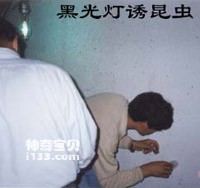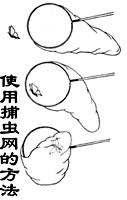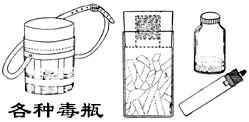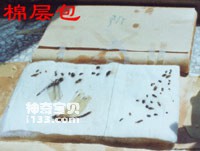Nets are generally used to catch butterflies, dragonflies, jumping locusts, etc. that are good at flying. Insects in large areas of grass and dense shrubs are difficult to see with the naked eye, so you can use a net to sweep them away. Use an insect net to sweep the net left and right while moving forward. You can also take advantage of the insect's habit of suspended animation and use a white cloth or insect umbrella to catch it under the tree. , and then vibrate the branches to cause the insects to fall dead due to the vibration. The fallen insects can be sucked up with a suction tube. Many insects have photophilic habits. On a windless and moonless night, choose a place with lush plants and running water to hang a lamp, and open a piece of white cloth behind the lamp. You can attract a lot of insects to stop on the cloth or Underground, you can use a finger tube to capture them one by one, and then poison them to death with a poison bottle. For moths, in order to avoid damaging the wings and scales due to wing flapping, anesthetics such as ether are usually used to stun the moths first and then poison them to death. Some moths and beetles like to eat honey. You can prepare sugar solution and put it in the field to attract insects. The glands of some female moths secrete an odor that causes distant male moths to "smell the scent" and gather next to the female moths, so that a large number of male moths can be caught without any effort.

For beginners, collecting insects must be comprehensive and cannot just rely on interest and hobbies. It is necessary to overcome the problem of picking only big insects but not small ones, picking only beautiful ones but not ugly ones, only picking special ones but not ordinary ones, picking only one insect of a kind but not the second one, picking male ones instead of female ones, and having adult insects. Don't use larvae, pick only flying ones and not hidden ones, etc. Only through comprehensive collection can we know the types, quantities and distribution of insects. Comparative identification can only be carried out through comprehensive collection. Only through comprehensive collection can precious specimens be collected.

In addition to continuing to raise the collected insects, they generally need to be killed immediately. The sooner the worms die, the more complete the specimen will be. Bottles are the best weapon for killing insects. Making a poison bottle is also very simple. Put some potassium cyanide in the lower part of the bottle, then cover it with a layer of sawdust (sawn wood), press the sawdust tightly with a wooden stick, and put a layer of gypsum paste on top. Insects will die immediately when put into the poison bottle, thus avoiding damage caused by collision. However, this kind of poisonous gas is also harmful to humans and animals, so be careful when using it and keep it in mind to prevent the poisonous gas from escaping. If there is no poison bottle at hand, you can use chloroform (chloroform) and other anesthetics instead. Large insects can be killed directly by injecting 40% carbolic acid or 95% alcohol with a syringe.
Insect larvae, eggs and pupae can be killed and preserved in 70% alcohol.

Adult insects are usually prepared as specimens within one day, because the insects become dry and hard after a few days and are difficult to prepare. However, collecting insects is often done in the wild, and specimens cannot be collected and prepared at any time. Therefore, poisoned specimens can be temporarily stored in paper triangular bags or cotton bags.

Easy way to make paper triangle bags:
The first type is made of rectangular or square paper folded into a triangle, and the opening is folded back and sealed. This kind of paper bag is suitable for insects with well-developed wings such as butterflies, moths, and dragonflies.
The second method is to use your fingers to open the bag and twist the lower corners tightly to make the bag bulge. This kind of paper bag is suitable for storing beetles, bees, flies, cicadas, etc. with thick bodies.
The third type of paper bag is folded with paper rolls and twisted tightly at both ends to form a long cylindrical paper bag, which is suitable for packaging long insects such as locusts, praying mantises, and beetles.
The fourth type of paper bag is a tighter paper tube, suitable for packaging leaves, twigs, insects, leaf miners, scale insects, etc. containing small insects. It is best to put only the same kind or similar specimens in each paper bag, one big one and several small ones. Only specimens collected at the same time and place can be put together. The date, place and collector of collection should be written on the outside. Messy specimens lose their use value. Paper bags can be made of transparent oil paper or cellophane, which can prevent moisture and allow insects inside the bag to be seen. The specimen must be dry, otherwise it will rot because the paper does not absorb water. Insects with a lot of moisture should be stored in paper bags made of thick burr paper or newspapers.

A cotton bag is a piece of absorbent cotton about 18 x 13 cm square, wrapped in kraft paper or old newspaper. Specimens are placed on the cotton from left to right, and those collected in the same batch are placed together. Specimens from different times and locations must be separated by lines when placed in a cotton bag. After filling, cover it with a piece of white paper, divide the paper according to the arrangement of the specimens, and write the collection place, quantity, etc. The entire package has a number, making it very convenient to save.
animal tags:
We created this article in conjunction with AI technology, then made sure it was fact-checked and edited by a Animals Top editor.